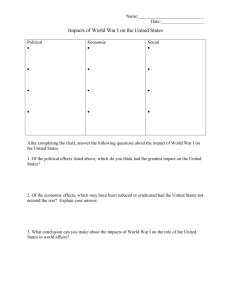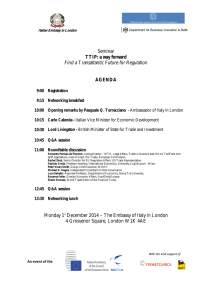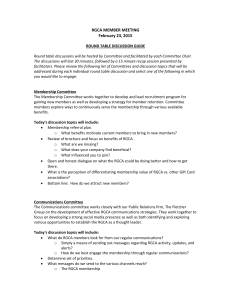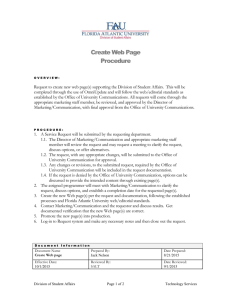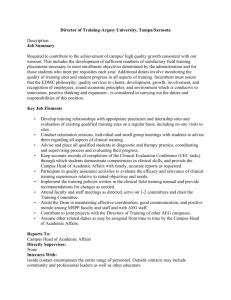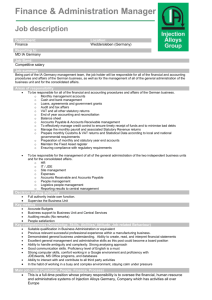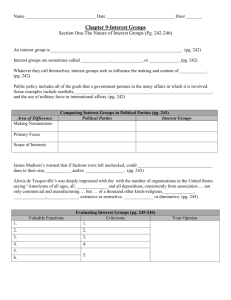Student Affairs
advertisement
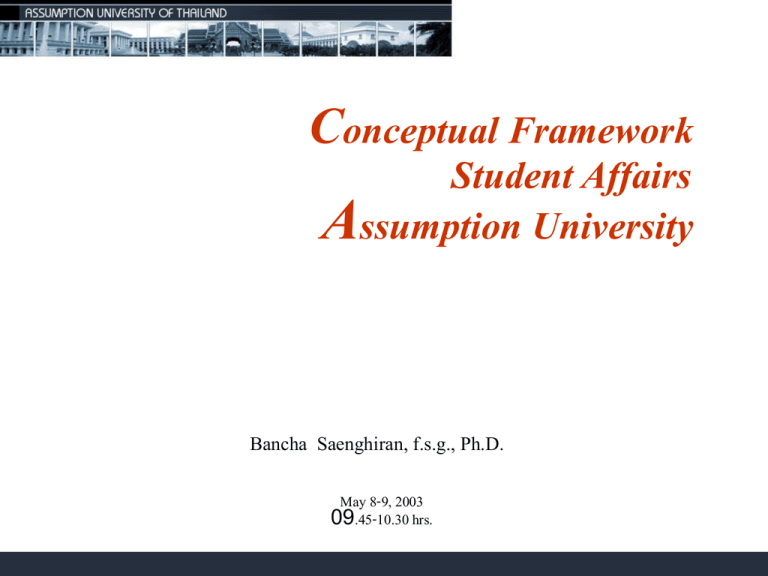
Conceptual Framework Student Affairs Assumption University Bancha Saenghiran, f.s.g., Ph.D. May 8-9, 2003 09.45-10.30 hrs. Origin of Student Affairs • In the student-centered philosophy • To assist students with the fulfillment and their full human potential At Present : • The shift from viewing colleges as places where instruction takes places to places where learning is fostered. Activities in 2002 • International Student Center • Information and Career Guidance and Counseling Center • Learning Support Center • Mental Hygiene and Personality Development Center • Professional Ethics (Center for …) • Student Activities (Center for …) • Student Residence Center • Center for Athletics • Division for Rights and Discipline, and Student Welfare Five Forces of Change • A changing student population, • Electronic educational technologies, • Accountability for outcomes, • Affordability of higher education, and • Changing faculty, staff, and student roles. Two Basic Approaches in Education (i) Content-Centered • Specialization and professionalization • Focus on training • Teaching to be delivered in any fashion (ii) Student-Centered • Developing an educated citizen • Able to earn a living know how to live • Mastery of information and good citizenship, ethics, values, and an appreciation for the aesthetic qualities of life. Three Models • Student Services Model • Student Development Model • Student Learning Model Student Services Model • To support the academic mission • To promote learning outside the classroom • To provide numerous adjunctive services to maintain the student in the classroom Student Development Model • To represent the maturation process • To focus on the development phases • Many different theories are used Student Learning Model • To achieve a more integrated or seamless learning experience • To establish learning goals or outcomes • To assess the success that is achieved • Outcomes are related to intentional learning, academic assistance, and enhanced academic climate. Observations 1. Student services model prevails as the predominant functional purpose for student affairs today. 2. Student development model and the student learning model seem to be gaining a place as additions to student affairs campus purpose and practice. 3. As the two newer functions are added the old still needs to be maintained. Implications 1. Divisions of student affairs are accumulating campus responsibilities. 2. Student affairs must review organizational structure and functions to determine the need for reorganization, prioritization of responsibilities, and redirection of resources. 3. Certain student offices are more likely to be involved in learning programs than others. Recommendations 1. There is a need to find ways to have flexible staffing patterns that will link units and develop coherent programs that serve students in a systemwide, coordinated manner. 2. Professionals should receive training in areas represented by the student learning model at levels of importance equal to training in student development and service functions. (to be cont’d) Recommendations (cont.) 3. Student affairs staff must establish outcome-based accountability for demonstrating program impact on student success. 4. Student affairs personnel can work to justify their legitimacy. The role of student affairs is to create environments and experiences that bring students to discover and conduct knowledge for themselves, to make students members of communities of learners that make discoveries and solve problems. To increase campus opportunities for student learning and to demonstrate learning outcomes. Seven Principles of Good Practice 1. To engage students in active learning. 2. To help students develop coherent values and ethical standards. 3. To set and communicate high expectations for learning. 4. To use systematic inquiry to improve student and institutional performance. 5. To use resources effectively to achieve institutional, missions and goals. 6. To forge educational partnerships that advance student learning. 7. To build supportive and inclusive communities. Questions to Pouder 1. How student affairs professionals can intentionally create campus conditions that enhance student learning and personal development ? 2. What is the relative importance of student services, student development, and student learning as constructs for practice ? 3. How do divisions of student affairs improve student learning and academic success of students ? (to be cont’d) 4. Where do learning opportunities for students emerge within student affairs organization ? 5. What percentage of student affairs resources are devoted to student learning, student development, and student service ? 6. Do you evaluate your programs for effectiveness and measure the learning outcomes you purport to instill in students ? Conclusion We value the impact student affairs is making and will make in the future in regard to have student learn, what students learn, and the environment in which learning takes place. Student Affairs 1. To understand conceptual framework of student affairs 2. To review the Vision/Mission of AU 3. To select operational model of student affairs 4. To prioritize the points of emphases and activities 5. To design structure ...
